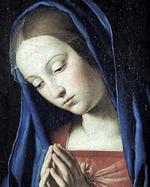Catholic Dictionary
Find accurate definitions of over 5,000 Catholic terms and phrases (including abbreviations). Based on Fr. John Hardon's Modern Catholic Dictionary, © Eternal Life. Used with permission.
Random Term from the Dictionary:
ST. JOSEPH, DEVOTION TO
Manifestation of reverence for the spouse of the Virgin Mary.
In the first centuries of the Church, there was no sign of a liturgical devotion to St. Joseph, which parallels the slow development of Marian piety and is understandable in view of the need first to stabilize the Church's Christology. However, the Eastern Fathers since the fourth century, such as Ephrem, John Damascene, and John Chrysostom, often speak of Joseph and extol his purity of life as in the classic phrase of St. Ephrem (306-73): "No one can worthily praise St. Joseph." The Latin Fathers, notably Jerome and Augustine, stress the justice of Mary's spouse, in the biblical sense of his fidelity to the laws of God. The earliest public cultus of St. Joseph appeared in the East, with June 20 the commemorative feast. Later Oriental sources variously assigned December 25, 26, and the Sunday before or after Christmas as feast days honoring St. Joseph at the head of other persons associated with the birth of Christ. By the ninth century the Western martyrologies celebrated his memory on March 19. The Crusades gave great impetus to the devotion, as seen in the basilica that the Crusaders built in honor of St. Joseph at Nazareth.
From the Middle Ages on, the veneration of the foster-father of Jesus entered the full stream of Christian piety, through the writings and preaching of Sts. Peter Damian, Bernard of Clairvaux, Thomas Aquinas, and Bernardine of Siena. Before the Council of Trent, the Feast of St. Joseph (March 19) was placed in the Roman Breviary by Pope Sixtus IV in 1479. And after Trent, by a decree of 1621, Pope Gregory XV made it a day of obligatory attendance at Mass and abstention from servile work, which it still remains according to canon law, except in certain countries such as the United States.
A parallel feast to honor the patronage of St. Joseph was extended by Pope Pius IX in 1870 to the whole Christian world, and at the same time the saint was declared "Patron of the Universal Church." In 1955, Pope Pius XII instituted a new feast of St. Joseph the Worker for May 1, and March 19 now commemorates his patronage of the Church.
St. Joseph's pre-eminent sanctity, which places him next to the Blessed Virgin among the saints, was confirmed by many papal documents, especially those of Popes Leo XIII and Pius XII. He is invoked as the patron of a happy death, and by a long-standing custom the month of March and each Wednesday of the week are dedicated to him. In paintings and statues he is usually shown with the Child Jesus and a lily or staff. More recent artists picture him with a carpenter's square or other instrument of his trade in his hand.






